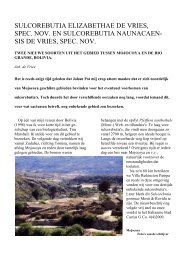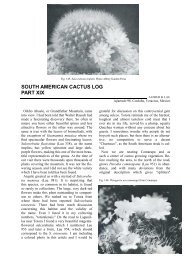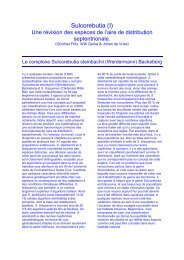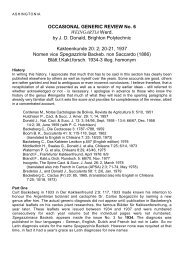Sulcorebutia in habitat
Sulcorebutia in habitat
Sulcorebutia in habitat
Create successful ePaper yourself
Turn your PDF publications into a flip-book with our unique Google optimized e-Paper software.
<strong>Sulcorebutia</strong> <strong>in</strong> <strong>habitat</strong><br />
(by Johan Pot)<br />
When Curt Backeberg <strong>in</strong> 1951 formulated the genus <strong>Sulcorebutia</strong>, he only knew plants <strong>in</strong><br />
culture. He had done observations, which gave him the belief to deal with a closed group of<br />
cacti, differ<strong>in</strong>g <strong>in</strong> some characters from all other plants. The flower looks like one of Rebutia,<br />
but the roots and sp<strong>in</strong>ation deviate. Moreover the tubercle has a short crack (“sulco”), from<br />
were the sp<strong>in</strong>es orig<strong>in</strong>ate. This was seen as the ma<strong>in</strong> character.<br />
Not everybody did agree with Backeberg. Mart<strong>in</strong> Cárdenas for example rejected<br />
“<strong>Sulcorebutia</strong>” as a genus. He described some new species as Rebutia, Aylostera or even<br />
We<strong>in</strong>gartia, which were recomb<strong>in</strong>ed some years later <strong>in</strong>to <strong>Sulcorebutia</strong>, for example by<br />
Friedrich Ritter.<br />
Ritter concluded, that the crack was no more than an imag<strong>in</strong>ation of Backeberg. The areole is<br />
very long and it cont<strong>in</strong>ues <strong>in</strong> top of the tubercle <strong>in</strong> a wr<strong>in</strong>kle towards the body. Such character<br />
is observed <strong>in</strong> other genera as well, for example <strong>in</strong> We<strong>in</strong>gartia. Moreover Ritter claimed, that<br />
Werdermann had made an error, when he believed to deal with a rebutia. Similarity of the<br />
flower was only due to convergence. The shape of the scales on the flower dist<strong>in</strong>ct<br />
<strong>Sulcorebutia</strong> clearly from Rebutia.<br />
There have been much confusion about the relationship of <strong>Sulcorebutia</strong>. Some professionals,<br />
like David Hunt, persist <strong>in</strong> their op<strong>in</strong>ion, the plants have to be classified as Rebutia. However<br />
it is remarkable, that specialists <strong>in</strong> the field hardly make errors to dist<strong>in</strong>ct sulcorebutias from<br />
other genera, even without see<strong>in</strong>g a flower. Often they are not able to expla<strong>in</strong> clearly, how<br />
they recognize the sulcos. Of course it will have to do with the knowledge, where they could<br />
expect to f<strong>in</strong>d these plants. But on the <strong>habitat</strong>s one can f<strong>in</strong>d Lobivias and sometimes<br />
Aylosteras as well. Nevertheless little errors are made.<br />
Meanwhile Dr. Ritz did <strong>in</strong>vestigation on chloroplast markers and found <strong>in</strong>deed a closed group<br />
of plants, consist<strong>in</strong>g of sulcorebutias and we<strong>in</strong>gartias.<br />
<strong>Sulcorebutia</strong> is found <strong>in</strong> South Bolivia from Tarija to Indepedencia, more or less <strong>in</strong> the bas<strong>in</strong>s<br />
of Rio Grande and Rio Pilcomayo, <strong>in</strong> an altitude between 1200 m and 4000 m.<br />
On the Cuesta de Sama <strong>Sulcorebutia</strong> tarijensis grows between 3200 and 3800 m. Plants have<br />
relatively little variation. This is uncommon <strong>in</strong> this genus. In many cases variability with<strong>in</strong> a<br />
population is strong, not only <strong>in</strong> body and sp<strong>in</strong>ation, but also <strong>in</strong> flower and seed. This makes it<br />
quite difficult to decide about relationships. That’s why I prefer to avoid the concepts<br />
“subspecies” and “variety”.<br />
The Cuesta de Sama is often hidden by clouds. Therefore the area is rather humid and the<br />
sulcorebutias look fresh green. At the westside of the Samapass it is much dryer. From there<br />
no sulcorebutias were reported.<br />
Many years S. tarijensis looked fully isolated from other populations. But recently<br />
sulcorebutias were found by Hansjörg Jucker <strong>in</strong> the area of Camargo and south of Azurduy.<br />
He explored the region of Nor and Sud C<strong>in</strong>ti, but did not do more discoveries. Obviously<br />
sulcos have not dispersed <strong>in</strong> that area, or they have died out.
From Azurduy to the north one can follow the Cordillera Mand<strong>in</strong>ga, east of the Rio<br />
Pilcomayo. S. azurduyensis was discovered not far from Azurduy <strong>in</strong> an altitude of 2500 m, S.<br />
cantargalloensis <strong>in</strong> an altitude of 3600 on the Cerro Cantar Gallo.<br />
Surpris<strong>in</strong>g was the discovery of Jucker <strong>in</strong> the same cordillera of sulcorebutias, which rem<strong>in</strong>d<br />
of we<strong>in</strong>gartias. They were described as <strong>Sulcorebutia</strong> juckeri. Similar plants were found on the<br />
west side of Rio Pilcomayo, not far from Turuchipa. A close relationship of these plants to<br />
We<strong>in</strong>gartia westii is assumed.<br />
North of the river plants are found, which are called mostly <strong>Sulcorebutia</strong> tarabucoensis. The<br />
type locality is not far from Tarabuco <strong>in</strong> an altitude of 3500 m. Around the village there are<br />
known many small populations, everyone with its own specific characters. Some of them<br />
were called S. aureiflora.<br />
North of Presto dark red flowered sulcos are found: S. pasopayana (3100 m). Some experts<br />
take them as closely related to S. tarabucoensis.<br />
Other such populations may be S. rauschii and S. hertusii, both from the area of Zudañez.<br />
In most of the collections we will f<strong>in</strong>d plants called “S. pulchra”, for example plants with the<br />
label “HS 78”. They were found between Presto and Sucre. Recently Johan de Vries<br />
published, that these plants cannot be S. pulchra. A relationship with S. canigueralii is<br />
assumed, what is reported from east of Sucre (3000 m).<br />
West of Sucre S. vasqueziana and S. losenickyana were found between 3000 m and 3900 m.<br />
Some of the populations <strong>in</strong> the area of Torotoro rem<strong>in</strong>d of these forms. One of them was<br />
described as S. cuprea (3000 m). Other similar plants are S. taratensis (Rio Ca<strong>in</strong>e, 3000 m),<br />
S. verticillacantha (north of Cerro Sayari, 3200-4000 m), S. tunariensis (road to Morochata,<br />
3600 m) and a species from Sacani (3900 m).<br />
Northwest of these populations yellow flowered sulcorebutias are found around Kami: S.<br />
kamiensis (3500-4000 m). These plants have certa<strong>in</strong> similarities with S. cuprea and S.<br />
verticillacantha.<br />
East of the Cordillera Mand<strong>in</strong>ga were found populations called S. crispata. Even more to the<br />
east a sulcorebutia was discovered, which rem<strong>in</strong>ds to S. crispata, but accepted to be another<br />
species: S. roberto-vasquezii (1300 m).<br />
Between Padilla and Pucara numorous populations are known, all called S. crispata, all of<br />
them with some particular outlook. Similar populations north of Zudañez got the name S.<br />
gemmae (2350-2700 m). More to the north S. elizabethae (2800 m) was found and at the other<br />
side of the Rio Grande, not far from Pasorapa S. cardenasiana (2600 m). There is a certa<strong>in</strong><br />
similarity of these plants to S. aureiflora and S. canigueralii.<br />
North of Vallegrande S. langeri (2000) was reported. It looks rather isolated. But its sp<strong>in</strong>ation<br />
rem<strong>in</strong>ds of S. crispata. Other such populations are known as S. albissima from the area of<br />
Aiquile (2400 m), but also S. august<strong>in</strong>ii from the road Omereque to Totora, 2600 m. Even S.<br />
mizquensis (Mizque 2600 m), some species of Tiraque (3100 m), S. glomerisp<strong>in</strong>a (Aguirre,<br />
3200 m) and S. krugerae (Cochabamba, 2600 m) show a certa<strong>in</strong> similarity. What to th<strong>in</strong>k of S.<br />
arenacea near Tiquipaya, 2200 m?<br />
<strong>Sulcorebutia</strong> torotorensis was described as a we<strong>in</strong>gartia, from the area of Torotoro <strong>in</strong> an<br />
altitude of 2000 m. Nowadays similar plants are found not far from the village <strong>in</strong> an altitude<br />
of 2950-3100 m. These plants show, like S. juckeri, a certa<strong>in</strong> similarity to We<strong>in</strong>gartia westii.<br />
North of the Rio Ca<strong>in</strong>e was reported the yellow flowered S. breviflora (2400-2700 m). Not far<br />
from there, along the road to Acacio, the magenta flowered S. gigantea has been discovered.<br />
Around San Pedro de Buena Vista grow big sulcorebutias with red flowers 2900-3400 m),<br />
which are similar to plants of the area of Carasi. We know such plants also from Poroma and
Copa Willkhi, south of the Rio Ca<strong>in</strong>e/Rio Grande. The last population has been identified as<br />
We<strong>in</strong>gartia neocum<strong>in</strong>gii. Even some populations called S. frankiana show similarity.<br />
North of the Rio, not far from the M<strong>in</strong>e Asientos, is the <strong>habitat</strong> of S. purpurea (2900-3000 m)<br />
and S. jolantana n.n. from Mol<strong>in</strong>ero (3000 m). Neighbour populations do not show only<br />
similarity with them, but also with albissima. S. mentosa however is not a very variable<br />
species, found around Aiquile (2300-2400 m).<br />
From here to the north-east S. prantneri(2900-3200 m) is found, S. totorensis, near Totora at<br />
2800 m and S. tiraquensis around Monte Punco at 2800-3100 m. Similar plants were<br />
discovered along the road to Santa Cruz: S. lepida, west of Pojo at 3000 m, S. aguilari, east of<br />
Pojo at 3000 m and S. krahnii, Comarapa, 2000-2400 m.<br />
Rema<strong>in</strong>s an area with extreme variable plants, such as S. polymorpha along the road between<br />
Tiraque and Monte Punco <strong>in</strong> an altitude of 3200-3400 m, S. hoffmannii from Arani (3000-<br />
3100 m) and last but not least S. ste<strong>in</strong>bachii from Colomi (3400 m). South of the latter many<br />
populations were discovered with different look<strong>in</strong>g plants, which all are called “ste<strong>in</strong>bachii”.<br />
It is assumed, that strong variability <strong>in</strong> such populations is caused by natural hybridization. Is<br />
it not strik<strong>in</strong>g, that exactly the type-plant of the genus came from such a population. Probably<br />
this is one reason, why it is that difficult to def<strong>in</strong>e the genus <strong>Sulcorebutia</strong>.<br />
Orig<strong>in</strong>ally published <strong>in</strong> Terra seca (France) 2011 N° 3 (p. 10 – 17)<br />
Reproduced with permission of the author and publisher<br />
This is the orig<strong>in</strong>al English text written by Johan Pot and lately translated <strong>in</strong> French for publication <strong>in</strong><br />
Terra seca.







